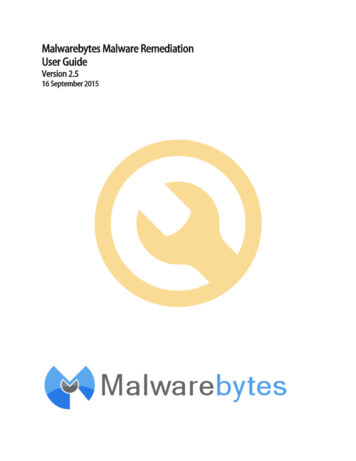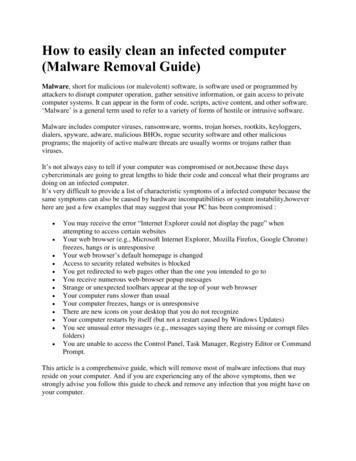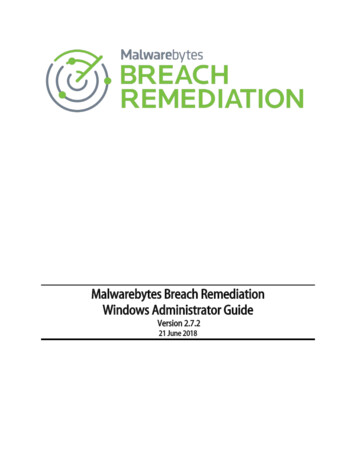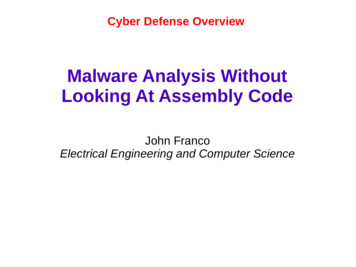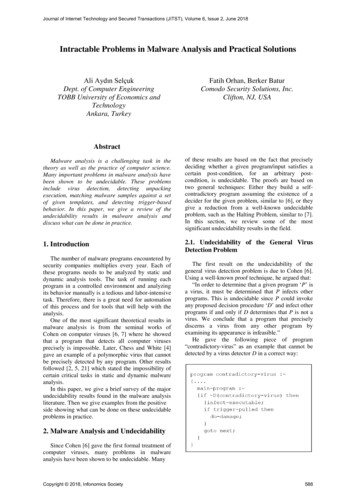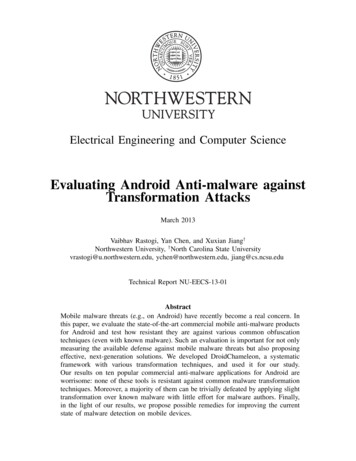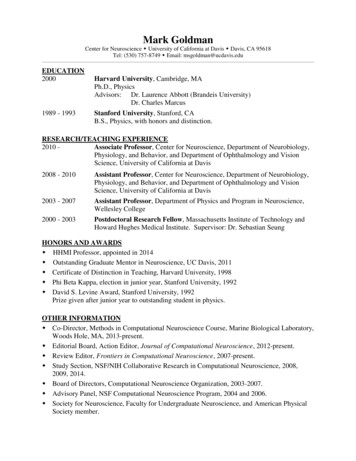
Transcription
Vietnam J Comput Sci (2017) 4:245–259DOI 10.1007/s40595-017-0095-3REGULAR PAPERComputational intelligence anti-malware framework for androidOSKonstantinos Demertzis1 · Lazaros Iliadis1Received: 2 May 2016 / Accepted: 15 February 2017 / Published online: 28 February 2017 The Author(s) 2017. This article is published with open access at Springerlink.comAbstract It is a fact that more and more users are adoptingthe online digital payment systems via mobile devices foreveryday use. This attracts powerful gangs of cybercriminals,which use sophisticated and highly intelligent types of malware to broaden their attacks. Malicious software is designedto run quietly and to remain unsolved for a long time. It manages to take full control of the device and to communicate (viathe Tor network) with its Command & Control servers of fastflux botnets’ networks to which it belongs. This is done toachieve the malicious objectives of the botmasters. This paperproposes the development of the computational intelligenceanti-malware framework (CIantiMF) which is innovative,ultra-fast and has low requirements. It runs under the androidoperating system (OS) and its reasoning is based on advancedcomputational intelligence approaches. The selection of theandroid OS was based on its popularity and on the numberof critical applications available for it. The CIantiMF usestwo advanced technology extensions for the ART java virtualmachine which is the default in the recent versions of android.The first is the smart anti-malware extension, which can recognize whether the java classes of an android applicationare benign or malicious using an optimized multi-layer perceptron. The optimization is done by the employment of thebiogeography-based optimizer algorithm. The second is theTor online traffic identification extension, which is capableof achieving malware localization, Tor traffic identificationBKonstantinos Demertziskdemertz@fmenr.duth.grLazaros Iliadisliliadis@fmenr.duth.gr1Lab of Forest-Environmental Informatics and ComputationalIntelligence, Democritus University of Thrace, 193Pandazidou st., 68200 N.Orestiada, Greeceand botnets prohibition, with the use of the online sequentialextreme learning machine algorithm.Keywords Android malware · Firmware malware · Mobilebanking malware · Rootkits · Ransomware · Onlinesequential extreme learning machine · Tor traffic analysis ·Botnets1 Introduction1.1 Android security modelOne of the most important features that distinguish theandroid OS, is the adoption of user identifiers (UIDs) whichimparts sophisticated security capabilities, compared to themodes of traditional OS. In particular, the android applications run as separate processes with different UIDs anddifferent permissions each. In this way, there is no application capable to read/write data or code to another, whereasif it is necessary to make data exchange with another application, it requires the assignment of specific permission. Itshould be noted that the android uses the mandatory accesscontrol (MAC) model in all of the processes, even in thosethat run with root/superuser privileges [1]. Specifically, thismodel is based on a security label system, which is attributedto both “subjects” (e.g. applications, users) and “objects”,which are the categories that manage information, relatedto different needs. This means that they can be assigned tosections of individual information within a system. Specifictypes of security clearance (classification labels) are assignedto the applications and to their corresponding data. In thisway, the android is based on security clearances, on the classification data labels and on the system’s security policies,123
246to reach a decision on which subject is entitled to access anobject.The classification data labels are assigned to each type ofobject (file, directory, device, network). Based on the security policies, the system checks the security clearances of a“subject” (e.g. user, application) by comparing them to theclassification data labels of an “object” (e.g. data, files) towhich access is sought. Access is not approved, if securitypolicies are not met. The MAC model is called mandatory[1], because the classification of “subjects” and “objects”is performed automatically by the system, without the intervention of users who theoretically cannot change these ratinglevels.1.2 Android rootkitsAn android rootkit [2] is a set of executable scripts andconfiguration files, allowing the continuous access to theroot/superuser privileges. It should be mentioned that theyactively hide their presence from the system administrators.This is done by their incorporation into basic android OS filesor other legitimate applications.Thus, they enable secret maintenance of the system’scontrol by executing commands or by stealing importantdata (e.g. credit card numbers, passwords, banking applications) totally unnoticed. Typically, an attacker installs anandroid rootkit by exploiting known security loopholes (zeroday exploit, unpatched), to obtain passwords (e.g. phishing,clickjacking), or to perform direct attack on encryption(brute-force attack, hijack attack) or through close-in attack(social engineering).The action of the rootkit, starts after the installation ofthe android OS, which is equivalent to simultaneous acquisition root/superuser privileges and after the installation of thenecessary “Payloads”.Then the rootkit is activated and redirects the system callsto completely conceal its presence. For example, when asystem function accesses a DLL library, it is misled by therootkit, which activates its own code to overtake the controlof its files. The kernel level rootkits [2] (which are the mostdangerous) have the following capabilities:(a) To change the privileges of a process (privilege escalation).(b) They can create or open doors against a security gap orprogram(c) They can create a coded or encrypted communicationchannel with C & C servers (HTTPS, Tor)(d) They can “load” drivers or collect and record information from the system in which they operate through keyloggers or password sniffers (telephone number, country, IMEI, model, android OS version, list of installedapps).123Vietnam J Comput Sci (2017) 4:245–259(e) It is possible to perform unstructured supplementary service data (USSD) request [1], even to neutralize thedefenses of the system by replacing legal with false andmalicious applications (e.g. Rogue security software,fake antivirus) [3].The malware response programs, if not themselves fake, theyperform out a scan in a modified system, where changes cannot be traced, since rootkits distort the files so that everysignature-based or difference-based control fails.Thus, the user cannot revoke the full administrator rightsfrom the malicious software, even if he uninstalls all applications that turned his phone a pawn of unknown forces,capable of an imperceptible files interception. It should bementioned that there are cases which even require the fullcancellation of the operating system.The firmware malware [3], a special category of androidrootkits, is extremely difficult to detect because the traditionalvirus scanners will not detect firmware threats.Android rootkits ransomware encrypt data and then theydemand money to unlock the victim’s files. If the money isnot paid within the period specified by the criminals, theythreaten to hold the decryption key, which is kept only on thehacker’s C & C server.Finally, the android rootkits are mainly mobile bankingmalware, which have been developed with the objective offinancial fraud. They are conducting illegal financial transactions and they steal money.The memory dumps analysis method is the most serious approach of treating these threats. It performs a forceddump of the operating system’s virtual memory to identifyan active rootkit. However, this technique is highly specific, it requires access to private source code, it is timeconsuming and it requires specialized personnel with therespective tools (digital forensic investigation tools). Moreover, it does not have the ability to detect every type of threat,as a hypervisor rootkit is able to monitor and to overturn thelower level of the system in an attempt to read the memory[3].1.3 Tor-based botnets and Tor traffic analysisThe objective of Tor [4] is to conceal the user IDs and theiractivity in the network to prevent the monitoring and analysisof the traffic and to separate the detection from the routingusing virtual circuits, or overlays, which change periodically.It is the implementation of onion routing [5], in whichmultiple layers of encryption are employed, to ensure perfectforward secrecy between the nodes and the hidden servicesof Tor, while launching randomly the communication viaTor nodes (consensus) operated by volunteers worldwide.Although the Tor network is operating in the Transport layerof the OSI, the onion proxy software shows customers the
Vietnam J Comput Sci (2017) 4:245–259secure socket interface (SOCKS) which operates in the session layer.Also, a continuous redirection of traffic requests betweenthe relays (entry guards, middle relays and exit relays), takesplace in this network. Both the sender and recipient addressesand the information are in the form of encrypted text, so thatno one at any point along the communication channel candecrypt the information or identify both ends directly [5]. Themost famous types of malware are seeking communicationrecovery and its maintenance with the C & C remote serverson a regular basis, so that botmasters can collect or transferinformation and upgrades to the compromised devices (bots).This communication is usually performed using hardcodedaddress or default lists address (pool addresses) controlledby the creator of the.The mode of communication of the latest, sophisticatedmalware generations, lies in the creation of an encryptedcommunication channel, based on the chaotic architectureof Tor, to alter the traces and to distort the elements thatdefine an attack and eventually to increase the complexity ofthe botnets.Although modern programming techniques enable themalware creators to use thousands, alternating and differentsubnet IP address, to communicate with their C2 servers, thetrace of those IPs is relatively straightforward for the networkengineers, or for the responsible security analysts. Once identified, they are included in a blacklist and eventually they areblocked as spam. On the other hand, the limitation of the Torbased botnets is extremely difficult because the movement ofthe Tor network resembles that of the HTTPS protocol.1.4 Tor vs HTTPSThe Tor network not only performs encryption, but it is alsodesigned to simulate normal HTTPS protocol traffic, whichmakes the identification of its channels an extremely complex and specialized process, even for experienced engineersor network analyzers. Specifically, the Tor network can usethe TCP port 443, which is used by the HTTPS, so that thesupervision and interpretation of a session exclusively withthe determination of the door cannot constitute a reliablemethod.A successful method for detecting Tor traffic is the statistical analysis and the identification of the secure socketslayer protocol differences (SSL) [6]. The SSL protocol usesa combination of public and symmetric key encryption. EachSSL connection always starts with the exchange of messagesby the server and the client until the secure connection isestablished (handshake). The handshake allows the serverto prove its identity to the client using public-key encryption techniques and then allows the client and the server tocooperate in the creation of a symmetric key to be used toquickly encrypt and decrypt data exchanged between them.247Optionally, the handshake also allows the client to prove itsidentity to the server [6]. Given that each Tor client createsself-signed SSL, using a random domain name that changesaround every 30 min, a statistical analysis of the networktraffic based on the specific SSL characteristics can identifythe Tor sessions, in a network full of HTTPS traffic.2 Innovation of the proposed methodAndroid rootkits are the most sophisticated and highlyintelligent malware techniques that make detection of “contamination” and analysis of malicious code, a very complextask. It is a fact that they spread through chaotic Tor-basedbotnets in which communication is done using the anonymityTor network, which makes it impossible to identify and locatethe C & C servers. In addition, the network traffic for the Torpacket is designed to simulate the respective traffic of theHTTPS protocol, which causes serious Tor traffic identification weaknesses by the motion analysis systems. Finally,given the passive mode of traditional android mobile security systems, which are unable in most cases to identify thesetypes of major threats, the development and use of alternative more radical and more substantial methods appear as anecessity. This work proposes the development and testing ofa novel computational intelligence system named CiantiMF.The system requires the minimum consumption of resourcesand it significantly enhances the security mechanisms of theandroid OS [7].Specifically, the architecture of the proposed systemis based on the hybrid use of two advanced ART JVM(ANDROID) extensions, namely the SAME and the OTTIE.The SAME uses a neural network, optimized with the BBOalgorithm and it is capable of recognizing whether the javaclasses of an android application are benign or malicious. TheOTTIE employs the OSELIM algorithm to perform malwarelocalization, Tor traffic identification and botnets prohibition.The CiantiMF system is a biologically inspired artificial intelligence computer security technique [8–12]. Unlikeother existing approaches which are based on individual passive safety techniques, the CiantiMF is an integrated activesafety system. It provides intelligent surveillance mechanisms and classification of malware, it is able to defend itselfand to protect from Rootkits malware, it detects and preventsencrypted Tor network activities and it can efficiently exploitthe potential of the hardware, with minimal computationalcost.A major innovation of the CiantiMF approach is related tothe architecture of the proposed hybrid computational intelligence system, which combines for the first time two very fastand highly effective biologically inspired machine learningalgorithms towards the solution of a multidimensional andcomplex IT security problem. Another novelty is the addi-123
248tion of a hybrid machine learning system as an extension tothe ART JVM, under the android OS. This addition poursintelligence at compiler level, something that significantlyenhances the defense mechanisms of the system, as well ascontrolling the outset dependencies of an application.Furthermore, a major innovative feature of this proposalis related to the identification and separation of the Tor network traffic from the traffic of the HTTPS protocol, whichis presented for the first time in static or dynamic networktraffic analysis systems.3 Related workSeveral publications discuss android-specific security mechanisms, involving overall security assessment of the platform[13], malware detection [14], application permission analysis [15], and kernel hardening [16]. Significant work hasbeen done in applying machine learning (ML) methods, usingfeatures derived from both static [17–19] and dynamic [20]analysis to identify malicious android applications [21], tonetwork traffic classification [22], malware traffic analysis[23] and botnets localization [24]. In parallel, several otherauthors [25–27] have also summarized scientific effort ofdetecting the botnets while proposing novel taxonomies ofdetection techniques, introducing different classes of botnetdetection and presenting some of the most prominent methods within the defined classes. Also, traffic analysis attackshave been extensively studied over the past decade [28,29].The authors have acknowledged the potential of machinelearning-based approaches in providing efficient and effective detection, but they have not provided a deeper insight intospecific methods, neither the comparison of the approachesby detection performances nor evaluation practice.On the other hand, Cheng et al. [30] proposed the useof ELM methods to classify binary and multi-class networktraffic for intrusion detection with high accuracy. Hsu et al.[31] proposed a real-time system for detecting botnets basedon anomalous delays in HTTP/HTTPS requests from a givenclient with very promising results. Also, Haffner et. al. [32]employed AdaBoost, hidden Markov, Naive Bayesian andmaximum entropy models to classify network traffic intodifferent applications, with very high secure shell (SSH, isa cryptographic network protocol operating at layer 7 of theOSI model to allow remote login and other network servicesto operate securely over an unsecured network) detection rateand very low false-positive rate, but they employed only fewbytes of the payload. Furthermore, Alshammari et al. [33]employed repeated incremental pruning, to produce errorreduction (RIPPER) and AdaBoost algorithms for classifyingSSH traffic from offline log files without using any payload,IP addresses or port numbers. Holz et al. [34] proposed a passive method to locate botnets and Apvrille et al. [35] propose123Vietnam J Comput Sci (2017) 4:245–259a heuristic engine that statically pre-processes and prioritizessamples to accelerate the detection of new android malwarein the wild. Crowdroid [36] made a first step towards the useof dynamic analysis results for android malware detection byperforming k means clustering based on system call invocation counts. Afonso et al. [37] dynamically analyze androidapps to use the number of invocations of API and system callsas coarse-grained features to train various classifiers. Theirmonitoring approach relies on modifying the app under analysis, which is easily detectable by malware. Dini et al. [38]proposed a multi-level anomaly detector for android malware(MADAM) system to monitors android at the kernel level anduser level to detect real malware infections using machinelearning techniques to distinguish between standard behaviors and malicious ones. The Droid Dolphin [39] approachrelies on repackaging an application with monitoring code.Chakravarty et al. [40] assess the feasibility and effectivenessof practical traffic analysis attacks against the Tor networkusing NetFlow data and proposed an active traffic analysismethod based on deliberately perturbing the characteristicsof user traffic at the server side, and observing a similarperturbation at the client side through statistical correlation.Almubayed et al. [41] proposed a research has consideredmany ML algorithms to fingerprint Tor usage in the network.Chaabane et al. [42] provides a deep analysis of both theHTTP and BitTorrent protocols giving a complete overviewof their usage, depict how users behave on top of Tor and alsoshow that Tor usage is now diverted from the onion routingconcept and that Tor exit nodes are frequently used as 1-hopSOCKS proxies, through a so-called tunneling technique.Finally, Chakravarty et al. proposed methods for performingtraffic analysis using remote network bandwidth estimationtools, to identify the Tor relays and routers involved in Torcircuits [43,44].4 Architecture of the CIantiMFThe architecture of the CIantiMF requires the creation of twoparallel extensions which act additionally and complementary to the function of the ART JVM. This injects artificialintelligence at android compiler level, significantly enhancing its active security. Specifically, SAME [45] analyzes thejava classes before they load and run a java application (classloader). Introduction of the files in the ART JVM passesnecessarily through the said extension in which it is checkedwhether the classes are benign or malicious. If they are foundmalicious, a decision is made, either automatically, if theaccuracy of classification exceeds a desired threshold, orafter an intervention of the system’s operator for the rejection and non-installation of the application. If the controlclass is found benign, then the installation process continues
Vietnam J Comput Sci (2017) 4:245–259249Fig. 1 The proposedarchitecture of the CIantiMFnormally without problems, while the user is informed thatit is a safe application.Then, when the application is executed, a control of thenetwork traffic that is generated by the application is performed to determine whether it is related to malicious sourcesor not. A thorough analysis is also carried out to identify thepotential encrypted traffic and accordingly if it is followingthe HTTPS protocol it is allowed, whereas if it is followingthe Tor protocol it is rejected by default as malicious.The proposed architecture of the CIantiMF is presentedin Fig. 1.It should be emphasized that the above architectural shapeoperates based on the dynamic analysis of the android sys-tem’s parameters, adapting the requirements of the runningapplications on the basis of stringent criteria and robust security policies.This adaptation is the result of an automatic process,derived from computational intelligence technologies, thusovercoming the potential inability of users to take timelymeasures to protect themselves. Finally, it is important thatthese malware identification procedures require fewer stepsthan the processor to analyze an application, resulting in abetter resources management and in less energy consumption.123
2504.1 Smart anti-malware extension (SAME)In our previous work [45], we have proposed the SAMEwhich introduces intelligence to the compiler and classifiesmalicious java classes in time to spot the android malwares.This is done by applying the java class file analysis (JCFA)approach and based on the effective BBO optimization algorithm, which is used to train a MLP.Generally, the source code java files (.java) of a java application are compiled to byte code files (.class) which areplatform independent and they can be executed by a JVMjust like ART which is an ahead-of-time (AOT) compiler. Theclasses are organized in the .java files with each file containing at least one public class. The name of the file is identicalto the name of the contained public class. The ART loads theclasses required to execute the java program (class loader)and then it verifies the validity of the byte code files beforeexecution (byte code verifier) [3]. The JCFA process includesalso the analysis of the classes, methods and specific characteristics included in an application. The SAME, introducesadvanced artificial intelligence (AI) methods, applied on specific parameters and data (obtained after the JCFA process)to perform binary classification of the classes comprisingan application, in benign or malicious. More specifically theSAME system employs the biogeography-based optimizer totrain a MLP which classifies the java classes of an applicationsuccessfully in benign or malicious.The architectural design of the SAME introduces an additional functional level inside the ARTJVM, which analyzesthe java classes before their loading and before the executionof the java program (class loader). The introduction of thefiles in the ARTJVM, always passes from the above level,where the check for malicious classes is done. If maliciousclasses are detected, decisions are done depending on theaccuracy of the classification. If the accuracy is high, thenthe decisions are done automatically, otherwise the actionsare imposed by the user regarding the acceptance or rejectionof the application installation. In the case that the classes arebenign, the installation is performed normally and the useris notified that this is a secure application [45].A basic innovation of the SAME is the inclusion of amachine learning approach as an extension of the ART JVMused by the android OS. This joint with the JCFA and thefact that the ART JVM resolves ahead-of-time all of thedependencies during the loading of classes, introduces Intelligence in compiler level. This fact enhances the defensivecapabilities of the system significantly. It is important thatthe dependencies and the structural elements of an application are checked before its installation enabling the malwarecases.An another important innovative part of this research isrelated to the choice of the independent parameters, whichwas done after several exhaustive tests, to ensure the max-123Vietnam J Comput Sci (2017) 4:245–259imum performance and generalization of the algorithm andthe consumption of the minimum resources.Finally, it is worth mentioning that the BBO optimizationalgorithm (popular for engineering cases) is used for the firsttime to train an artificial neural network (ANN) for a realinformation security problem.4.2 Online Tor traffic identification extension (OTTIE)The TTIE is essentially a tool for analysis of web streaming traffic in fixed intervals, to extract timely conclusions inwhich some or all of the incoming data are not available foraccess from any permanent or temporary storage medium,but those arrive in a form of consecutive flows. For thesedata there is no control over the order in which they arrive,their size may vary and many of them offer no real information. Also the examination of individual IP packets orTCP segments can extract only a few conclusions and therefore the interdependence of the individual packets to eachother, their analysis cannot be done with simple static methods, but it requires further modeling of traffic and the use ofadvanced analytical methods for the extraction of knowledgefrom complex data sets. This modeling in TTIE is achievedby the use of the computational intelligence online sequentialextreme learning machine (OSELM) algorithm.The extreme learning machine (ELM) as an emergingbiologically inspired learning technique provides efficientunified solutions to “generalized” single-hidden layer feedforward networks (SLFNs) but the hidden layer (or called feature mapping) in ELM need not be tuned [46]. Such SLFNsinclude but are not limited to support vector machine, polynomial network, RBF networks, and the conventional feedforward neural networks. All the hidden node parametersare independent from the target functions or the trainingdatasets and the output weights of ELMs may be determinedin different ways (with or without iterations, with or withoutincremental implementations). ELM has several advantages,ease of use, faster learning speed, higher generalization performance, suitable for many nonlinear activation functionand kernel functions.According to the ELM theory [46], the ELM with Gaussian radial basis function kernel (GRBFK) K (u, v) exp( γ u v 2 ) is used in this approach. The hidden neurons are k 20 that chosen with trial and error method.Subsequently, wi are the assigned random input weights andbi , i 1, . . . , N are the biases. To calculate the hidden layeroutput matrix H , the Eq. (1) is used. h (x1 )h 1 (x1 ) · · · h L (x1 ) .H . .h (x N )h 1 (x N ) · · · h L (x N )(1)
Vietnam J Comput Sci (2017) 4:245–259251h(x) [h 1 (x), ., h L (x)] is the output (row) vector of thehidden layer with respect to the input x. Also h(x) actuallymaps the data from the d-dimensional input space to the Ldimensional hidden-layer feature space (ELM feature space)H and thus h(x) is indeed a feature mapping. ELM is tominimize the training error as well as the norm of the outputweights:Minimize : Hβ T 2 and β (2)where H is the hidden-layer output matrix of the equation (1), β is used to minimize the norm of the output weights andactually to maximize the distance of the separating marginsof the two different classes in the ELM feature space 2/ β .To calculate the output weights β the function (3) is used: β I HTHC 1H TT(3)where c is a positive constant is obtained and T resulting fromthe function approximation of SLFNs with additive neurons t1T T . [46]t NTwhich is an arbitrary distinct sample withti [ti1 , ti2 , . . ., tim ]T R m [47]The OSELM is an alternative technique for large-scale computing and machine learning approaches that used when databecome available in a sequential order to determine a mapping from data set corresponding labels. The main differencebetween online learning and batch learning techniques is thatin online learning the mapping is updated after the arrival ofevery new data point in a scale fashion, whereas batch techniques are used when one has access to the entire trainingdata set at once. It is a versatile sequential learning algorithmbecause the training observations are sequentially (one-byone or chunk-by-chunk with varying or fixed chunk length)presented to the learning algorithm. At any time, only thenewly arrived single or chunk of observations (instead of theentire past data) are seen and learned. A single or a chunk oftraining observations is discarded as soon as the learning procedure for that particular (single or chunk of) observation(s)is completed. The learning algorithm has no prior knowledge as to how many training observations will be presented.Unlike other sequential learning algorithms which have manycontrol parameters to be tuned, OSELM with RBFkernel onlyrequires the number of hidden nodes to be specified [47,48].The proposed method uses an OSELM that can learn datachunk-by-chunk with a fixed chunk size of 20 20, with RBFkernel classification approach to perform malware localization, Tor traffic identification and botnets prohibition in anenergetic security mode that needs minimum computationalresources and time [7]. The OSELM consists of two mainphases namely: boosting phase (BPh) and sequential learning phase (SLPh). The BPh used to train the SLFNs using theprimitive ELM method with some batch of training data inthe initialization stage and these boosting training data willbe discarded a
1.1 Android security model One of the most important features that distinguish the android OS, is the adoption of user identifiers (UIDs) which imparts sophisticated security capabilities, compared to the modes of traditional OS. In particular, the android appli-cations run as separate processes with different UIDs and different permissions each.
